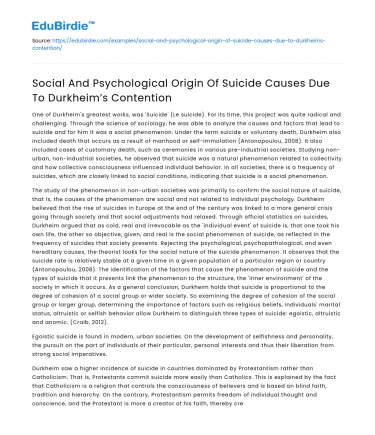One of Durkheim's greatest works, was 'Suicide' (Le suicide). For its time, this project was quite radical and challenging. Through the science of sociology, he was able to analyze the causes and factors that lead to suicide and for him it was a social phenomenon. Under the term suicide or voluntary death, Durkheim also included death that occurs as a result of manhood or self-immolation (Antonopoulou, 2008). It also included cases of customary death, such as ceremonies in various pre-industrial societies. Studying non-urban, non-industrial societies, he observed that suicide was a natural phenomenon related to collectivity and how collective consciousness influenced individual behavior. In all societies, there is a frequency of suicides, which are closely linked to social conditions, indicating that suicide is a social phenomenon.
The study of the phenomenon in non-urban societies was primarily to confirm the social nature of suicide, that is, the causes of the phenomenon are social and not related to individual psychology. Durkheim believed that the rise of suicides in Europe at the end of the century was linked to a more general crisis going through society and that social adjustments had relaxed. Through official statistics on suicides, Durkheim argued that as cold, real and irrevocable as the 'individual event' of suicide is, that one took his own life, the other so objective, given, and real is the social phenomenon of suicide, as reflected in the frequency of suicides that society presents. Rejecting the psychological, psychopathological, and even hereditary causes, the theorist looks for the social nature of the suicide phenomenon. It observes that the suicide rate is relatively stable at a given time in a given population of a particular region or country (Antonopoulou, 2008). The identification of the factors that cause the phenomenon of suicide and the types of suicide that it presents link the phenomenon to the structure, the 'inner environment' of the society in which it occurs. As a general conclusion, Durkheim holds that suicide is proportional to the degree of cohesion of a social group or wider society. So examining the degree of cohesion of the social group or larger group, determining the importance of factors such as religious beliefs, individuals' marital status, altruistic or selfish behavior allow Durkheim to distinguish three types of suicide: egoistic, altruistic and anomic. (Craib, 2012).
Save your time!
We can take care of your essay
- Proper editing and formatting
- Free revision, title page, and bibliography
- Flexible prices and money-back guarantee
Egoistic suicide is found in modern, urban societies. On the development of selfishness and personality, the pursuit on the part of individuals of their particular, personal interests and thus their liberation from strong social imperatives.
Durkheim saw a higher incidence of suicide in countries dominated by Protestantism rather than Catholicism. That is, Protestants commit suicide more easily than Catholics. This is explained by the fact that Catholicism is a religion that controls the consciousness of believers and is based on blind faith, tradition and hierarchy. On the contrary, Protestantism permits freedom of individual thought and conscience, and the Protestant is more a creator of his faith, thereby creating religious individualism. Altruistic suicide occurs in societies with a high degree of assimilation into the collective life. A total way of enforcing collective consciousness towards the individual can lead individuals to ethical commitments. Suicide can thus appear as a sacrifice, a duty of individuals, and in contrast to the selfish suicide, the ego is not a property of ourselves, but obeys something external to the group in which it participates (Craib, 2012).
Finally, anomic suicide occurs where the rules governing social life have become absent, and we no longer know how to behave or what to do in a situation or not. This is often observed in times of crisis and sudden changes (e.g. loss of wealth). These transitional periods or periods of crisis do not contribute to the social integration of individuals and there is a general confusion with old and new rules and social requirements.






 Stuck on your essay?
Stuck on your essay?

